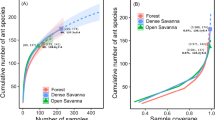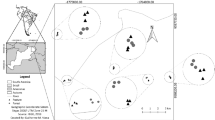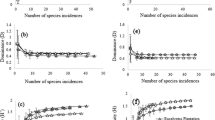Abstract
In the south of Brazil, grasslands are naturally widespread over two different biomes, the Pampa in the southernmost region and within the Atlantic Forest in the northern portions. The natural grasslands of the state of Paraná comprise a very particular physiognomy composed of two distinct formations: the Campos Gerais and the grasslands of the southwest. The first is located in the edge of the second plateau of Paraná state, comprising a great diversity of environments. The grasslands of the southwest are more homogeneous, with a continuous herbaceous stratum dominating the landscape. In this context, the aim of this study was to evaluate the patterns of species richness and composition of ants, an ecologically prominent group, along the natural grasslands of Paraná. We also intended to compare the faunal similarity between the two different grassland formations. For that, four different Conservation Unities were sampled along a latitudinal gradient. A remarkable total of 245 ant species was recorded, and the results indicate that species richness decreases as latitude increases along the grasslands of Paraná. There were clear differences in species composition between these two grasslands formations, given the significative number of endemic species in each of these two grassland formations. Ten species were recorded for the first time in the state of Paraná, of which three also for the first time in the Southern Region of Brazil. Overall, our study contributes to a better understanding about the diversity and composition of ant communities in subtropical grasslands.





Similar content being viewed by others
References
Ab’Sáber AN (2003) Os Domínios de Natureza do Brasil: Potencialidades paisagísticas. Ateliê Editorial, São Paulo, Brazil
Albuquerque NL, Brandão CRF (2009) A revision of the Neotropical Solenopsidini ant genus Oxyepoecus Santschi, 1926 (Hymenoptera: Formicidae: Myrmicinae): 2. Final Key for species and revision of the Rastratus species-group Pap Avulsos Zool 49:289–309. https://doi.org/10.1590/S0031-10492009002300001
Albuquerque EZ, Diehl E (2009) Análise faunística das formigas epígeas (Hymenoptera: Formicidae) em campo nativo no planalto das Araucárias, Rio Grande do Sul. Rev Bras Entomol 53(3):398–403
Alonso LE (2000) Ants as indicators of diversity. In: Agosti D, Majer JD, Alonso LE, Schultz TR (eds) Ants: Standard methods for measuring and monitoring biodiversity. Smithsonian Institution Press, Washington, USA, pp 80–88
Andersen AN (1992) Regulation of "momentary" diversity by dominant species in exceptionally rich ant communities of the Australian seasonal tropics. Am Nat 140(3):401–420. https://doi.org/10.1086/285419
Andrade BO, Bonilha CL, Overbeck GE, Vélez-Martin E, Rolim RG, Bordignon SAL, Schneider AA, Ely CL, Lucas DB, Garcia EN, Santos ED, Torchelsen FP, Vieira MS, Silva Filho PJS, Ferreira PMA, Trevisan R, Hollas R, Campestrini S, Pillar VD, Boldrini II (2019) Classification of South Brazilian grasslands: Implications for conservation. Appl Veg Sci 22:168–184. https://doi.org/10.1111/avsc.12413
Antiwiki.org (2021) https://www.antwiki.org/wiki/Brazil. Acessed 26 Mar 2021
Baccaro FB, Feitosa RM, Fernandez F, Fernandes IO, Izzo TJ, de Souza JP, Solar R (2015) Guia para os gêneros de formigas do Brasil. Editora INPA, Manaus, Brazil
Baselga A, Orme CDL (2012) Betapart: a R package for the study of beta diversity. Methods Ecol Evol 3:808–812. https://doi.org/10.1111/j.2041-210X.2012.00224.x
Behling H (1997) Late Quaternary vegetation, climate and fire history in the Araucaria forest and campos region from Serra Campos Gerais (Paraná). S Brazil Rev Palaeobot Palynol 97:109–121. https://doi.org/10.1016/S0034-6667(96)00065-6
Behling H, Pillar VD, Orlóci L, Bauermann SG (2004) Late Quaternary Araucaria forest, grassland (Campos), fire and climate dynamics, studied by high-resolution pollen, charcoal and multivariate analysis of the Cambará do Sul core in southern Brazil. Palaeogeogr Palaeoclimatol Palaeoecol 203:277–297. https://doi.org/10.1016/S0031-0182(03)00687-4
Bestelmeyer BT, Agosti D, Alonso LE, Brandão CRF, Brown WL Jr, Delabie JHC, Silvestre R (2000) Field techniques for the study of ground-dwelling ants: an overview, description, and evaluation. In: Agosti D, Majer JD, Alonso LE, Schultz TR (eds) Ants: Standard methods for measuring and monitoring biodiversity. Smithsonian Institution Press, Washington, USA, pp 122–144
Bolton B (2020) An online catalog of the ants of the world. http://antcat.org
Boscardin J, Garlet J, Costa EC (2013) Mirmecofauna epigéica (Hymenoptera: Formicidae) em plantios de Eucalyptus spp. (Myrtales: Myrtaceae) na região oeste do estado do Rio Grande do Sul. Brasil. Entomotropica. 27(3):119–128
Brandão CRF, Mayhé-Nunes AJ (2001) A new fungus-growing ant genus, Mycetagroicus gen. n., with the description of three new species and comments on the monophyly of the Attini (Hymenoptera: Formicidae). Sociobiology. 38(3B):639–665
Brandão CRF, Mayhé-Nunes AJ (2008) A new species of the fungus-farming ant genus Mycetagroicus Brandão & Mayhé-Nunes (Hymenoptera, Formicidae, Attini). Rev Bras Entomol 52:349–352
Bridgewater S, Ratter JA, Ribeiro JF (2004) Biogeographic patterns, beta-diversity and dominance in the Cerrado biome of Brazil. Biodivers Conserv 13:2295–2318. https://doi.org/10.1023/B:BIOC.0000047903.37608.4c
Brower JE and Zarr JH (1984) Field and laboratory methods for general ecology. W. C. Brown Publishers, Iowa, USA.
Brown WL Jr (1976) Contributions toward a reclassification of the Formicidae. Part VI. Ponerinae, tribe Ponerini, subtribe Odontomachiti. Section A. Introduction, subtribal characters. Genus Odontomachus. Stud Entomol 19:67–171
Brown WL Jr (1978) Contributions toward a reclassification of the Formicidae. Part VI. Ponerinae, tribe Ponerini, subtribe Odontomachiti. Section B. Genus Anochetus and bibliography. Stud Entomol 20:549–638
Brown WL Jr (2000) Diversity of Ants. In: Agosti D, Majer JD, Alonso LE, Schultz TR (eds) Ants: Standard Methods for Measuring and Monitoring Biodiversity. Smithsonian Institution Press, Washington, USA, pp 45–79
Brown WL Jr, Kempf WW (1960) A world revision of the ant tribe Basicerotini. Stud Entomol 3:161–250
Camacho GP (2013) Estudo taxonômico do grupo striatula de Gnamptogenys Roger (Hymenoptera, Formicidae, Ectatomminae) para o Brasil. Dissertation. Universidade Federal de Viçosa, Viçosa, Brazil.
Camacho GP, Franco W, Feitosa RM (2020) Additions to the taxonomy of Gnamptogenys Roger (Hymenoptera: Formicidae: Ectatomminae) with an updated key to the New World species. Zootaxa. 4747(3):450–476. https://doi.org/10.11646/zootaxa.4747.3.2
Carlucci MB, Duarte LS, Pillar VD (2011) Nurse rocks influence forest expansion over native grasslands in southern Brazil. J Veg Sci 22:111–119. https://doi.org/10.1111/j.1654-1103.2010.01229.x
Carmo MRB, Moro RS, Nogueira MKFS (2007) A vegetação florestal nos Campos Gerais. In: Melo MS, Moro RS, Guimarães GB (eds) Patrimônio Natural dos Campos Gerais do Paraná. Editora UEPG, Ponta Grossa, Brazil, pp 99–104
Chao A, Gotelli NJ, Hsieh TC, Sander EL, Ma KH, Colwell RK, Ellison AM (2014) Rarefaction and extrapolation with Hill numbers: a framework for sampling and estimation in species diversity studies. Ecol Monogr 84:45–67. https://doi.org/10.1890/13-0133.1
Coutinho LM (1978) O conceito de Cerrado. Rev Bras Bot 1:17–23
Cuezzo F (2000) Revisión del género Forelius (Hymenoptera: Formicidae: Dolichoderinae). Sociobiology. 35:197–275
Dröse W, Podgaiski LR, Cavallieri A, Feitosa RM, Mendonça MS Jr (2017) Ground – Dwelling and vegetation ant fauna in Southern Brazil grasslands. Sociobiology. 64(4):381–392 https://doi.org/10.13102/sociobiology.v64i4.1795
Fernández F (2008) Subfamilia Ponerinaem. In: Jíminez E, Fernández F, Arias TM, Lozano-Zambrano FH (eds) Sistematica, biogeografia y conservación de las hormigas cazadoras de Colombia. Instituto Alexander von Humboldt, Bogota, Colombia, pp 123–218
Gonçalves CR (1961) O gênero Acromyrmex no Brasil (Hym. Formicidae). Stud Entomol 4:113–180
Gotelli NJ, Ellison AM (2002) Biogeography at a regional scale: Determinants of ant species density in new england bogs and forests. Ecology. 83:1604–1609. https://doi.org/10.1890/0012-9658
Hauck PAH, Passos E (2010) A Paisagem de Vila Velha, seu significado para a Teoria dos Refúgios Florestais e a evolução do Domínio Morfoclimático dos Planaltos das Araucárias. RAEGA. 19:155–164
Hsieh TC, Ma KH, Chao A (2016) iNEXT: an R package for rarefaction and extrapolation of species diversity (Hill numbers). Methods Ecol Evol 7(12):1451–1456. https://doi.org/10.1111/2041-210X.12613
Iapar (1994) Instituto Agronômico do Paraná, Cartas climáticas do Estado do Paraná. Londrina, Brazil
Itcg (2008) Instituto de Terras, Cartografia e Geologia do Paraná, Mapa de climas do estado do Paraná. http://www.itcg.pr.gov.br/arquivos/File/ProdutosDGEO/MapasITCG/PDF/Mapa_Climas_A3.pdf. Acessed 10 Nov 2020
Kaspari M (2000) A primer on ant ecology. In: Agosti D, Majer JD, Alonso LE, Schultz TR (eds) Ants: Standard methods for measuring and monitoring biodiversity. Smithsonian Institution Press, Washington, USA, pp 9–24
Kempf WW (1972) Catálogo abreviado das formigas da região neotropical (Hymenoptera: Formicidae). Stud Entomol 15:3–344
Klunk CL, Giehl ELH, Lopes BC, Marcineiro FR, Rosumek FB (2018) Simple does not mean poor: grasslands and forests harbor similar ant species richness and distinct composition in highlands of southern Brazil. Biota Neotrop 18(3):e20170507. https://doi.org/10.1590/1676-0611-bn-2017-0507
Kugler C, Brown WL Jr (1982) Revisionary and other studies on the ant genus Ectatomma, including the description of two new species. Search Agric (Ithaca N Y) 24:1–8
Kusnezov N (1957) Numbers of species of ants in faunae of diferent latitudes. Evolution. 11:298–299
Lassau SA, Hochuli DF (2004) Effects of habitat complexity on ant assemblages. Ecography. 27:157–164
Lattke JE (1990) Revision del genero Gnamptogenys Roger en Venezuela (Hymenoptera: Formicidae). Acta Terramaris 2:1–47
Lattke JE, Fernández F and Palacio EE (2007) Identification of the species of Gnamptogenys Roger in the Americas. In: Snelling RR, Fisher BL and Ward PS (eds). Advances in ant systematics: homage to E.O. Wilson – 50 years of contributions. Memoirs of the American Entomological Institute, Philadelphia, USA, pp. 254-270
Legendre P, Legendre L (1998) Numerical ecology, 2nd edn. Elsevier Science B.V, Amsterdam, Holand
Lewinsohn TM, Freitas AVL, Prado PI (2005) Conservation of terrestrial invertebrates and their habitats in Brazil. Conserv Biol 19:640–645
Longino JT and Fernández F (2007) Taxonomic review of the genus Wasmannia. In: Snelling RR, Fisher BL and Ward PS (eds). Advances in ant systematics: homage to E.O. Wilson – 50 years of contributions. Memoirs of the American Entomological Institute, Philadelphia, USA, pp. 271–289
Lutinski JA, Lopes BC, Morais ABB (2013) Diversidade de formigas urbanas (Hymenoptera: Formicidae) de dez cidades do sul do Brasil. Biota Neotropica 13(3):332–342. https://doi.org/10.1590/S1676-06032013000300033
Maack R (1946) Notas preliminares sobre uma nova estratigrafia do Devoniano do Estado do Paraná. In: Congresso Pan-Americanos de Engenharia de Minas e Geologia 2, Rio de Janeiro, Anais. Rio de Janeiro, v.4.
Maack R (1948) Notas preliminares sobre clima, solos e vegetação do estado do Paraná. Curitiba, Arquivos de Biologia e Tecnologia 2:102–200
Maack R (1981) Geografia física do Estado do Paraná. Livraria José Olympio, Rio de Janeiro, Brazil
Mackay WP, Mackay EE (2010) The systematics and biology of the new world ants of the genus Pachycondyla (Hymenoptera: Formicidae). Edwin Mellon Press, Lewiston, USA
Magurran AE (2004) Measuring biological diversity. Blackwell Publishing, Oxford, England
Marinho CGS, Zanetti R, Delabie JHC, Schlindwein MN, Ramos LS (2002) Diversidade de formigas (Hymenoptera: Formicidae) da serapilheira em eucaliptais (Myrtaceae) em área de cerrado de Minas Gerais. Neotrop Entomol 31(2):187–195. https://doi.org/10.1590/S1519-566X2002000200004
Mayhé-Nunes AJ, Brandão CRF (2005) Revisionary studies on the attine ant genus Trachymyrmex Forel. Part 2: the Iheringi group (Hymenoptera: Formicidae). Sociobiology. 45(2):271–305. https://doi.org/10.11646/zootaxa.1444.1.1
Mayhé-Nunes AJ, Brandão CRF (2006) Revisionary notes on the fungus-growing ant genus Mycetarotes Emery (Hymenoptera, Formicidae). Rev Bras Entomol 50:463–472. https://doi.org/10.1590/S0085-56262006000400005
Melo MS, Meneguzzo IS (2001) Patrimônio natural dos Campos Gerais do Paraná. In: Ditzel CHM, Löwen Sahr CL (eds) Espaço e Cultura: Ponta Grossa e os Campos Gerais. Editora UEPG, Ponta Grossa, Brazil, pp 271–289
Ness JH, Bronstein JL (2004) The effects of invasive ants on prospective ant mutualists. Biol Invasions 6(4):445–461. https://doi.org/10.1023/B:BINV.0000041556.88920.dd
Oliveira A, Feitosa R, Vasconcelos H, Maravalhas J (2016) New distribution records of the savana specialist fungus-farming ant Cyatta Sosa-Calvo et al (Hymenoptera: Formicidae: Myrmicinae). Biodivers Data J 4:e10673. https://doi.org/10.3897/BDJ.4.e10673
Overbeck GE, Müller SC, Fidelis A, Pfadenhauer J, Pillar VD, Blanco CC, Boldrini II, Both R, Forneck ED (2007) Brazil's neglected biome: the South Brazilian Campos. Perspect Plant Ecol Evol Syst 9:101–116. https://doi.org/10.1016/j.ppees.2007.07.005
Overbeck GE, Boldrini II, Carmo MRB, Garcia EN, Moro CE, Pinto CE, Trevisan R, Zannin A (2015a) Fisionomia dos Campos. In: Pillar VD, Lange O (eds) Os Campos do Sul. Rede Campos Sulinos – UFRGS, Porto Alegre, Brazil, pp 31–39
Overbeck GE, Vélez-Martin E, Scarano FR, Lewinsohn TM, Fonseca CR, Meyer ST, Müller SC, Ceotto P, Dadalt L, Durigan G, Ganade G, Gossner MM, Guadagnin DL, Lorenzen K, Jacobi CM, Weisser WW, Pillar VD (2015b) Conservation in Brazil needs to include non-forest ecosystems. Divers Distrib 21:1455–1460. https://doi.org/10.1111/ddi.12380
Pacheco JA, Mackay WP (2013) The systematics and biology of the New World thief ants of the genus Solenopsis (Hymenoptera: Formicidae). Edwin Mellen Press, Lewiston, New York.USA
Peck JE (2010) Multivariate analysis for community ecologists: Step-by-step using PC-ORD. MJM Software Design. Gleneden Beach, Oregon. USA.
Pfeiffer M, Chimedregzen L, Ulykpan K (2003) Community organization and species richness of ants (Hymenoptera/Formicidae) in Mongolia along an ecological gradient from steppe to Gobidesert. J Biogeogr 30:1921–1935. https://doi.org/10.1046/j.0305-0270.2003.00977.x
Pillar VD, Lange O (2015) Os campos do Sul. Rede Campos Sulinos UFRGS, Porto Alegre, Brazil
R Core Team (2019) R: A language and environment for statistical computing. R Foundation for Statistical Computing, Vienna, Austria. URL http://www.R-project.org/
Ritter LMO (2008) Composição Florística e aspectos Físicos do Cerrado nos Campos Gerais. Dissertation, Universidade Estadual de Ponta Grossa, Ponta Grossa, Paraná, Brazil, Paraná
Rosado JLO, de Gonçalves MG, Dröse W, Silva EJE, Krüger RF, Feitosa RM, Loeck AE (2012) Epigeic ants (Hymenoptera: Formicidae) in vineyards and grassland areas in the Campanha region, state of Rio Grande do Sul. Brazil Checklist 8:1184–1189. https://doi.org/10.15560/8.6.1184
Schmidt CA, Shattuck SO (2014) The higher classification of the ant subfamily Ponerinae (Hymenoptera: Formicidae), with a review of ponerine ecology and behavior. Zootaxa. 3817(1):1–242. https://doi.org/10.11646/zootaxa.3817.1.1
Silva RR, Brandão CRF (2014) Ecosystem-Wide Morphological Structure of Leaf-Litter Ant Communities along a Tropical Latitudinal Gradient. PLoS One 9(3):e93049. https://doi.org/10.1371/journal.pone.0093049
Silva-Melo A, Giannotti E (2012) Division of Labor in Pachycondyla striata Fr. Smith, 1858 (Hymenoptera: Formicidae: Ponerinae). Psyche, ID 153862:1–7. https://doi.org/10.1155/2012/153862
Smith AM, Fisher BL, Hebert PDN (2005) DNA barcoding for effective biodiversity assessment of a hyperdiverse arthropod group: the ants of Madagascar. Philos Trans R Soc Lond Ser B Biol Sci 360:1825–1834. https://doi.org/10.1098/rstb.2005.1714
Sosa-Calvo J, Schultz T, Brandão CF, Klingenberg C, Feitosa R, Rabeling C, Bacci M, Lopes C, Vasconcelos H (2013) Cyatta abscondita: Taxonomy, Evolution, and Natural History of a New Fungus-Farming Ant Genus from Brazil. PLoS One 8(11):e80498. https://doi.org/10.1371/journal.pone.0080498
Uhlmann A, Galvão F, Silva SM (1998) Análise da estrutura de duas unidades fitofisionômicas de savana (Cerrado) no sul do Brasil. Acta Bot Bras 12(3):211–247. https://doi.org/10.1590/S0102-33061998000300005
Vasconcelos HL, Maravalhas JB, Feitosa RM, Pacheco R, Neves KC, Andersen AN (2018) Neotropical savanna ants show a reversed latitudinal gradient of species richness, with climatic drivers reflecting the forest origin of the fauna. J Biogeogr 45:248–258. https://doi.org/10.1111/jbi.13113
Veloso HP, Rangel Filho ALR, Lima JCA (1991) Classificação da vegetação brasileira, adaptada a um sistema universal. IBGE – DERMA, Rio de Janeiro, Brazil
Wall DH, Moore JC (1999) Interactions underground: soil biodiversity, mutualism, and ecosystem processes. BioScience. 49(2):109–117. https://doi.org/10.2307/1313536
Ward PS, Brady SG, Fisher BL, Schultz TR (2014) The evolution of myrmicine ants: phylogeny and biogeography of a hyperdiverse ant clade (Hymenoptera: Formicidae). Syst Entomol 40(1):61–81. https://doi.org/10.1111/syen.12090
Ward PS, Blaimer BB, Fisher BL (2016) A revised phylogenetic classification of the ant subfamily Formicinae (Hymenoptera: Formicidae), with resurrection of the genera Colobopsis and Dinomyrmex. Zootaxa 4072(3):343–357. https://doi.org/10.11646/zootaxa.4072.3.4
Watkins JF (1976) The identification and distribution of New World army ants (Dorylinae: Formicidae). Baylor University Press, Waco, Texas, USA
Wetter JK, Porter SD (2003) The little fire ant, Wasmannia auropunctata: distribution, impact, and control. Sociobiology. 42:1–42
Wild AL (2007) Taxonomic revision of the ant genus Linepithema (Hymenoptera: Formicidae). Univ Calif Publ Entomol 126(7):1–151
Wilson EO (1976) Which are the most prevalent ant genera? Stud Entomol 19:187–200
Wilson EO, Hölldobler B (2005) The rise of the ants: A phylogenetic andecological explanation. PNAS. 102(21):7411–7414. https://doi.org/10.1073/pnas.0502264102
Ziller SR (2000) A estepe gramíneo-lenhosa no segundo planalto do Paraná: diagnóstico ambiental com enfoque à contaminação biológica. Thesis, Universidade Federal do Paraná, Curitiba, Paraná, Brazil
Acknowledgements
We thank the following specialists in different ant genera who confirmed the species identified in this study: Alexandre Casadei Ferreira (Pheidole), Aline Machado de Oliveira (Cephalotes), Emília Z. de Albuquerque (Cyphomyrmex and Mycetophylax); Lina Maria Pedraza (Crematogaster), Lívia P. Prado (Octostruma), Mayron Escárraga (Linepithema), Rodolfo Probst (Myrmelachista), and Thiago S. Ranzani da Silva (Strumigenys). This work was supported by the Brazilian Council of Research and Scientific Development (CNPq grants 459353/2014-4 and 457407/2012-3). Finally, WF and RMF thank the CNPq for the grants 141234/2018-0 and 302462/2016-3, respectively.
Funding
(Conselho Nacional de Desenvolvimento Científico e Tecnológico- CNPq; Grants 141234/2018-0; 302462/2016-3; 459353/2014-4; 457407/2012-3)
Author information
Authors and Affiliations
Contributions
Weslly Franco: contributed substantially in the concept of the study, in data collection, data analysis and interpretation, and to prepare the manuscript; Heraldo Luis Vasconcelos contributed to data analysis and interpretation and did a critical revision, adding intellectual content; Rodrigo M. Feitosa: contributed substantially in the concept of the study, in data collection, data interpretation, and to prepare the manuscript
Corresponding author
Additional information
Edited by Fernando B Noll
Publisher’s Note
Springer Nature remains neutral with regard to jurisdictional claims in published maps and institutional affiliations.
Supplementary Information
ESM 1
(PDF 1747 kb)
Rights and permissions
About this article
Cite this article
Franco, W., Vasconcelos, H.L. & Feitosa, R.M. Patterns of Ant Diversity in the Natural Grasslands of Southern Brazil. Neotrop Entomol 50, 725–735 (2021). https://doi.org/10.1007/s13744-021-00886-y
Received:
Accepted:
Published:
Issue Date:
DOI: https://doi.org/10.1007/s13744-021-00886-y




